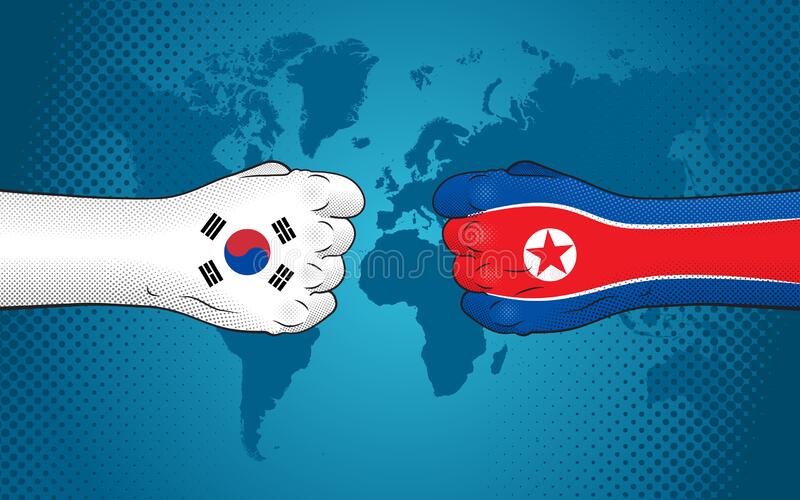- info@preciousfountain.org
- +234 806 870 0572

It is no new information that South Korea and North Korea have been divided for more than 70 years now . While South Korea has grown massively in Technology and entertainment, North Korea has grown in arms, nuclear weapons and ammunition. Korea has often been the centre of conflicts among larger and more powerful countries and this had a great impact on their division.
Before the division
The Korean Peninsula was a united territory under the Joseon dynasty that ruled over the region for more than 500 years, starting from 1392 after the fall of the Goryeo dynasty. This rule came to an end in 1910, with the Japanese annexation of Korea. Between 1910 and 1945, Korea was ruled as a part of the Empire of Japan. The Korean Empire, proclaimed in 1897, became a protectorate of Japan with the Japan–Korea Treaty of 1905; thereafter Japan ruled the country indirectly through the Japanese Resident-General of Korea . Japan formally annexed Korea with the Japan–Korea Treaty of 1910, without the consent of the former Korean Emperor Gojong, the regent of Emperor Sunjong. Upon its annexation, Japan declared that Korea would henceforth be officially named Joseon. This name was recognized internationally until the end of the Japanese occupation. Japanese rule over Korea ended on 15 August 1945 with the surrender of Japan in World War II; the armed forces of the United States and the Soviet Union subsequently occupied this region.
The Role of World War II in the division of Korea
World War II began in the early part of 1939 when the German dictator Adolf Hitler made efforts to invade and occupy Poland. Poland, for its part, had guarantees of French and British military support should it be attacked by Germany . However, the Empire of Japan entered World War II on 22 September 1940 when it invaded French Indochina, at this time Korea was annexed by Japan. Japan made its entrance into the war official five days later with the signing of the Tripartite Pact with Germany and Italy on 27 September 1940, but it wasn’t until the attack on Pearl Harbour on 7 December 1941 that the U.S. entered the conflict . The United States and Japan had been engaged in negotiations in an attempt to improve their strained relations and end the war in China. During these negotiations, Japan advanced several proposals which were dismissed by the Americans as inadequate. Frustrated at the lack of progress and feeling the pinch of the American–British–Dutch sanctions, Japan prepared for war. The attack was a surprise military strike by the Imperial Japanese Navy Air Service upon the United States against the naval base at Pearl Harbour on Sunday, December 7, 1941. The United States was a neutral country at the time; the attack led to its formal entry into World War II the next day. Japan intended the attack as a preventive action. It aimed to prevent the United States Pacific Fleet from interfering with its planned military actions in Southeast Asia against overseas territories of the United Kingdom, the Netherlands, and those of the United States.
However, the tide turned in 1942 when Japan was bombed for the first time in the Doolittle Raid. This setback was followed in June 1942 by the catastrophic loss of four fleet carriers at the Battle of Midway, the first decisive defeat for the Imperial Japanese Navy. Australian land forces defeated Japanese Marines in New Guinea at the Battle of Milne Bay in September 1942, which was the first land defeat suffered by the Japanese in the Pacific . In the summer of 1944, the United States Army Air Forces undertook an intense strategic bombing campaign, using incendiary bombs, burning Japanese cities to pulverize Japan’s industry and shatter its morale. In mid-August 1945, the United States dropped nuclear weapons on the Japanese cities of Hiroshima and Nagasaki. These atomic bombings were the first and only such weapons used against another nation in warfare .
Despite Soviet–Japanese Neutrality Pact, at the Yalta agreement in February 1945, the US, the UK and the USSR had agreed that the USSR would enter the war on Japan within three months of the defeat of Germany in Europe. It was agreed that Soviet troops would occupy the northern portion of Korea, while American forces would take similar action in southern Korea to secure the area and liberate it from Japanese control. On August 9, Soviet forces invaded northern Korea and a few days later, Japan surrendered. Keeping to their part of the bargain, U.S. forces entered southern Korea on September 8, 1945 . This Soviet–Japanese War led to the fall of Japan’s Manchurian occupation and a real, imminent threat of Soviet invasion of the home islands of Japan.
The Aftermath of World War II
Because Japan surrendered earlier than the US expected, the US at that point did not have a base in Korea and feared a full takeover of the peninsula by the Soviet forces. The absence of US troops was mainly due to a miscalculation of when Japan would surrender. To restrict the USSR from seizing the entire peninsula, the US suggested a temporary division of the Korean peninsula between the US and the USSR. The U.S. proposed dividing the Korean peninsula into two occupation zones (a U.S. and Soviet one) with the 38th parallel as the dividing line.
The Soviets accepted their proposal and agreed to divide Korea . It was understood that this division was only a temporary arrangement until the trusteeship could be implemented. The Moscow Conference of Foreign Ministers in December 1945 resulted in an agreement on a four-power Korean trusteeship lasting up to five years.
The Final Division
However, with the onset of the Cold War and other factors both international and domestic, including Korean opposition to the trusteeship, negotiations between the United States and the Soviet Union over the next two years regarding the implementation of the trusteeship failed, thus effectively nullifying the only agreed-upon framework for the re-establishment of an independent and unified Korean state . With this, the Korean question was referred to the United Nations. In 1948, after the UN failed to produce an outcome acceptable to the Soviet Union, UN-supervised elections were held in the US-occupied south only. The American backed Syngman Rhee won the election, while Kim Il-sung consolidated his position as the leader of Soviet-occupied northern Korea. This led to the establishment of the Republic of Korea in South Korea on 15 August 1948, promptly followed by the establishment of the Democratic People’s Republic of Korea in North Korea on 9 September 1948. The United States supported the South, the Soviet Union supported the North, and each government claimed sovereignty over the whole Korean peninsula .
In 1950, after years of mutual hostilities, North Korea, supplied and advised by the Soviet Union invaded South Korea in an attempt to re-unify the peninsula under its communist rule . The United Nations, with the United States as the principal participant, joined the war on the side of the South Koreans, and the People’s Republic of China came to North Korea’s aid. After more than a million combat casualties had been suffered on both sides, the fighting ended in July 1953 with Korea still divided into two hostile states. The Korean War, which lasted from 1950 to 1953, ended with a stalemate and has left Korea divided by the Korean Demilitarized Zone (DMZ) up to the present day.

1 Comment
Very insightful.